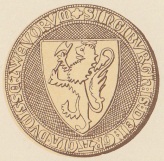Ingeborg, Duchess of Öland facts for kids
Quick facts for kids Ingeborg |
|
|---|---|
| Duchess of Finland | |

Seal of Ingeborg.
|
|
| Born | 1297 |
| Died | 1357 (aged 59–60) |
| Spouse | Valdemar, Duke of Finland |
| House | Sverre |
| Father | Eric II of Norway |
| Mother | Isabel Bruce |
Ingeborg, Duchess of Öland (Norwegian: Ingebjørg Eiriksdatter) was a Norwegian princess born in 1297. She became a Swedish duchess and held the titles of Duchess of Uppland, Öland, and Finland. After her husband passed away, she played a part in the government that ruled for her young nephew, Magnus. Magnus was king of both Sweden and Norway. Ingeborg lived until 1357.
Early Life and Family
Ingeborg was the daughter of King Eric II of Norway and Isabel Bruce. Her father, King Eric II, died on July 15, 1299. At that time, Ingeborg was only one or two years old. Since her father had no sons, his younger brother, Haakon V, became the new king.
In 1300, when Ingeborg was just three years old, her mother arranged for her to be engaged. She was to marry Jon Magnusson, Earl of Orkney. However, this marriage never happened. It is not clear if the engagement was called off or if Jon Magnusson died before Ingeborg was old enough to marry.
A Royal Wedding
In 1312, Ingeborg had a special double wedding in Oslo. Her mother helped arrange this important event. Ingeborg married Valdemar, Duke of Finland, who was the youngest brother of the Swedish king, Birger. At the same time, her younger cousin, Ingeborg, married Birger's oldest brother, Eric, Duke of Södermanland.
When Ingeborg married, she received the island of Öland as a special gift of land. Because of this, she was sometimes called the Duchess of Öland. In 1316, she had a son, but sadly, he likely died when he was very young.
A Difficult Time
A difficult event happened on the night of December 10-11, 1317. Ingeborg's husband, Valdemar, and his brother Eric were visiting King Birger in Nyköping. During their visit, they were arrested and put in chains.
After their husbands were imprisoned, Ingeborg and her cousin, Ingeborg Håkansdotter, became leaders for their husbands' supporters. On April 16, 1318, "the two duchesses Ingeborg" made an agreement in Kalmar. They worked with Duke Christoffer of Halland-Samsö from Denmark and Archbishop Esgar of Lund. Their goal was to free their husbands. They promised not to make peace with the kings of Sweden and Denmark until their husbands were released.
Later that same year, it was confirmed that their husbands had died.
Life as a Widow
In 1318, the "two duchesses Ingeborg" were mentioned as working with Mats Kettilmundsson to help govern. It seems Ingeborg might have had a role in the government that looked after her cousin Ingeborg's young son, King Magnus. King Magnus was too young to rule by himself. However, there is no full list of who was in this government, so her exact role is not fully known. Her sister-in-law, Ingeborg Håkansdotter, remained a powerful political figure for many years.
Ingeborg Eriksdotter was known as the Duchess of Öland from at least 1340. She lived in Sweden for a long time after her husband's death, until her own passing in 1357.

